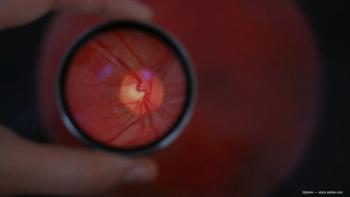
New-generation presbyopia-correcting IOL
The U.S. IDE clinical trial of the investigational extended range of vision IOL (Model ZXR00; Tecnis Symfony Extended Range of Vision IOL, Abbott Medical Optics) found that the implant delivered a full range of uncorrected vision and minimized or eliminated the need for spectacle wear in most patients.
Sioux City, IA-Results from the 6-month follow-up visit in a U.S. Investigational Device Exemption (IDE) clinical trial show that an investigational extended range of vision IOL (Model ZXR00; Tecnis Symfony Extended Range of Vision IOL, Abbott) provides better near and intermediate vision with reduced spectacle dependence after cataract surgery compared with a monofocal IOL, and it achieves those outcomes while maintaining good distance vision, said Jason Jones, MD.
“The extended range of vision IOL has a novel optic design that aims to deliver a full range of high-quality uncorrected vision, and it seems to have met that goal based on the outcomes from the U.S. IDE clinical trial. According to the data in this study, patients who are bilaterally implanted with the extended range of vision IOL may expect an uncorrected visual acuity of about 20/20 at distance and intermediate and between 20/25 and 20/32 for near,” commented Dr. Jones, US IDE clinical trial investigator and president, Jones Eye Clinic, Sioux City, IA.
Related:
“Patients receiving the extended range of vision IOL also did well in terms of safety and satisfaction with visual quality, and my patients who found any need for spectacles typically only used them perhaps once a week if they were reading very small print or in challenging light conditions.”
The extended range of vision IOL merges two complementary technologies-a proprietary echellete design that elongates focus to extend the range of vision with a proprietary achromatic technology that reduces chromatic aberration for enhanced contrast sensitivity.
More:
The U.S. IDE clinical trial randomized 298 patients enrolled at 15 centers to bilateral implantation of the extended range of vision IOL or an aspheric acrylic 1-piece monofocal IOL (model ZCB00; Tecnis, Abbott). All but four patients were evaluable at 6 months.
Outcomes assessed included visual acuity (VA) and defocus curve testing that was done monocularly after implantation of the first eye and after binocular implantation at the 6-month visit.
Mean logMAR uncorrected intermediate visual acuity (UCIVA) was the primary endpoint in the study, and the data analyses showed it was significantly better in eyes implanted with the extended range of vision IOL compared with the controls in both monocular testing (0.087 vs. 0.256; p <0.0001) and binocularly (0.002 vs. 0.134; p<0.0001). Similarly, mean logMAR distance-corrected IVA (DCIVA) was significantly better in recipients of the extended range of vision IOL than in the controls in monocular (0.104 vs. 0.342; p<0.0001) and binocular testing (0.032 vs. 0.227; p<0.0001).
Recent:
In addition, the proportion of patients achieving monocular UCIVA of 20/25 or better was two-fold higher in the group implanted with the presbyopia-correcting IOL compared with the controls (76.9% vs. 33.8%); 70.1% of the patients receiving the extended range of vision IOL and only 13.5% of controls achieved monocular DCIVA of 20/25 or better.
Statistically significant differences favoring the extended range of vision IOL versus the control lens were also consistently achieved in comparisons of mean logMAR near VA in monocular and binocular testing with and without distance correction.
“Near VA outcomes for the group with the extended range of vision IOL were about 2 lines better than for the controls, and only 16% of controls but 62% of the extended range of vision IOL recipients achieved DCNVA of 20/40 or better,” Dr. Jones reported.
More:
Defocus curve testing was done in a subset of 62 patients implanted with the extended range of vision IOL and 73 patients in the control group. In binocular testing performed at the 6-month visit, mean visual acuities for the extended range of vision IOL group were better than 20/32 through intermediate defocus values of -1.5 D (66 cm), and the results showed a 1- to 2-line difference (better VA) compared with the monofocal group through -4.0 D of defocus.
Testing of monocular uncorrected and best-corrected distance visual acuity of first eyes implanted and after binocular implantation at 6 months showed good outcomes in both groups with no clinically relevant differences.
More:
Almost two-thirds of patients implanted with the extended range of vision IOL reported wearing glasses “none of the time” compared with just about one-third of control patients. Overall, 85% of patients in the extended range of vision IOL group said they wore spectacles “none of the time” or “a little of the time” and the proportion with those outcomes was significantly higher than in the monofocal IOL group (59.9%; p<0.001).
No safety concerns emerged. There were no reports of lens decentration or IOL glistening at 6 months, and no differences between groups in lens findings/adverse events.
Jason Jones, MD
This article is from a presentation given by Dr. Jones at the 2016 American Society of Cataract and Refractive Surgery (ASCRS) Symposium. Dr. Jones was paid as an investigator for his participation in the U.S. IDE clinical trial, but he has no other relevant financial interests to disclose.
Newsletter
Don’t miss out—get Ophthalmology Times updates on the latest clinical advancements and expert interviews, straight to your inbox.









































